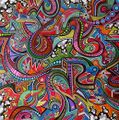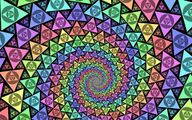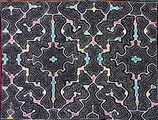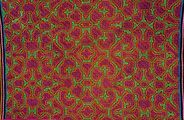Geometry: Difference between revisions
>Josikins |
>Josikins |
||
| Line 47: | Line 47: | ||
*'''Organic vs. Synthetic''' - Geometry can either feel organic and natural in its visual style or it can synthetic and digital. | *'''Organic vs. Synthetic''' - Geometry can either feel organic and natural in its visual style or it can synthetic and digital. | ||
*'''Structured vs. Unstructured''' – Geometry can either present itself as completely unorganized and unstructured or they can form and condense into an infinite variety of 3-Dimensional mechanistic and ever-shifting structures which are comprised out of and based upon condensed geometry. | *'''Structured vs. Unstructured''' – Geometry can either present itself as completely unorganized and unstructured or they can form and condense into an infinite variety of 3-Dimensional mechanistic and ever-shifting structures which are comprised out of and based upon condensed geometry. | ||
*'''Dark vs. Bright''' - | *'''Dark vs. Bright''' - Geometry can either present itself as extremely dark and hard to make out from its background or in contrast it can be brightly lit and extremely easy to distinguish from its background. | ||
*'''Multicoloured vs. Monotone''' – The colour scheme that geometry follows can range from extremely varied and-multi coloured in style to consisting of little if any colour variety such as blues and greys or purples and blacks | *'''Multicoloured vs. Monotone''' – The colour scheme that geometry follows can range from extremely varied and-multi coloured in style to consisting of little if any colour variety such as blues and greys or purples and blacks | ||
*'''Flat shading vs. Glossy shading''' – This is separate from the variety of colour contained within geometry. Colours can either be flat, bright and simplistic or glossy with depth, high lights and shading. | *'''Flat shading vs. Glossy shading''' – This is separate from the variety of colour contained within geometry. Colours can either be flat, bright and simplistic or glossy with depth, high lights and shading. | ||
Revision as of 10:56, 15 May 2014

Geometry can be described as the experience of a person’s field of vision being partially or completely encompassed by fast-moving, kaleidoscopic, and indescribably complex geometric patterns, form constants, shapes, fractals, structures and colour.
Geometry never stands still at any point and is often extremely fast-changing and self-transforming in terms of its shape and style. During this process, the geometry naturally drifts laterally or radially across the visual field to create overlapping webs of many arising and decaying geometric patterns, all of which are visible within a single perceptual frame.
There are eight different levels of visual geometry, each one increasingly complex and incomprehensible. These are defined and documented below:
- Visual Noise – This is the most basic level of geometry and can be experienced in a completely sober state. It can be described as visual noise or static combined with random light and dark red regions that can be seen under the eyelids.
- Motion and Colour – This level is also easily obtainable without hallucinogens and can be described as the appearance of unstructured regions of fleeting flashes and clouds of colour.
- Partially Defined Geometry - At this level complex indescribable shapes and patterns begin to show themselves. However, the patterns can be described as strictly 2-dimensional. They are fine, small, and zoomed out in size with a dark colour palette that limits itself to only a few different shades such as blacks, reds and dark purples. They are displayed in front of both the open and closed-eye visual field across a flat veil of geometry, but are significantly more detailed with the eyes closed or within dark environments.
- Fully Defined Geometry – This is the level where the detail in which the geometry displays itself becomes profoundly complex but remains strictly 2-Dimensional. At this point the visuals become large in size and extremely intricate in detail with a colour palette that is limitless in its possibilities. They are displayed on both the open and closed-eye visual field across a flat veil of geometry that floats directly in front of the eyes, remaining significantly more detailed with the eyes closed or in dark environments.
- 3-Dimensional Geometry – At level five, the geometry will become fully 3-dimensional in their shape and position across the visual field. This adds a whole new layer of visual complexity and leaves them sprawled out across the surfaces, walls, objects and furniture of ones environment instead of displaying themselves across a basic and flat veil in front of ones visual field.
- Partially Overriding Visual Perception – At this point the geometry has become so intense, vivid and bright that it has begun to block out and replace the external world. At level six the environment begins to be replaced by geometry, with objects and scenery transforming into sprawling masses of geometry or simply being blocked out and covered by them in a way that partially impairs the use of ones normal vision.
- Fully Overriding Visual Perception – As the geometry continues to become more intense, vivid and bright it now completely blocks out and replaces the external world as ones sense of normal sight becomes completely impaired. This creates the sensation that one is no longer within the external environment but has broken through into another reality.
- Level 8A and Level 8B - Once the geometry reaches its eighth and final level, there is not one singular pinnacle of visual geometry but two. It seems that depending on subtle environmental factors and the substance consumed, geometry is capable of forking off into two separate versions of their highest possible level. This means that level eight geometry will have to be separated into two distinct categories of equal intensity. These are known as levels 8A and 8B. Once visual geometry reaches level 8A or 8B, they begin to become structured and organized in a way that presents genuine information to the person experiencing them far beyond the preceding seven levels. This happens through the experience of innately understood geometric representations that feel as though they depict specific concepts and neurological components that exist within the brain. At this point, concepts can be seen as not just embedded within ones closed or open-eye visual field, but simultaneously felt through complex physical and cognitive sensations.
8A - Exposure to entirety of neurological structure
The experience of level 8A can be described as the feeling feel of being exposed to an infinite mass of geometry comprised entirely of innately readable geometric representations which simultaneously convey every single internally stored concept, memory, and neurological structure stored within the subconscious mind all at once. This results in a profound and overwhelming sensation which is consistently interpreted by people who undergo it as experiencing the entirety of existence, everything, the universe, all that there ever was and all that there ever will be in a single instant.
This experience is not just perceived as visual data but also physically felt in an incomprehensible level of detail throughout every point across itself as complex and innately understandable tactile sensations which occur across the body. These convey an equal amount of identical information as that which is experienced through ones sense of vision and occurs simultaneously along side of it.
At the lower side of level 8A, this effect is something that fluctuates wildly and remains neither constant nor consistent in its intensity. Instead it is temporarily triggered by the experience of a concept. For example, if somebody were to say the word “internet” to a person who is currently undergoing this state, they would see the mind's concept of the internet immediately manifested in a geometric form amidst the very centre of their visual field. This form quickly branches out from itself in a fashion similar to an ineffable spider diagram. It expands to envelops the concepts which one associates with the internet and then branches out again to include the concepts one associates with those before repeating the process of branching out further to represent the concepts associated with these ad infinitum. Within 2 - 3 seconds, this exponentially expands within a sudden perceptual flash to include every single internally stored concept within the subconscious memory banks of ones mind simultaneously.
Once this occurs, the sensory overload temporarily disconnects the tripper from their external environment and results in simultaneous ego death before re-stacking them back into the room, until something triggers the process again (usually immediately). The effect snaps trippers in and out of the room repeatedly and the process is triggered continuously. It's worth noting however that at this level it can to a certain extent be held at bay through continuous physical movement. This is because movement stops the process from branching out into everything by not giving the effect the time it needs to lock onto a concept.
As dosage is increased, the process becomes easier and easier to trigger whilst extending in its length and duration. This eventually results in a stable state of complete disconnection from the external environment alongside of sustained ego death and a lasting sense of experiencing the entirety of ones neurological structure.
8B - Exposure to inner mechanics of human consciousness
The experience of level 8B can be described as the feeling of being exposed to a mass of geometry comprised entirely of innately readable geometric representations which feel as if they convey the organization, structure, framework and inner mechanics of the underlying programming behind all conscious and subconscious neurological processes. This effect is consistently interpreted by those who undergo the experience as perceiving the inner workings of either the universe, consciousness or reality.
At the lower end of level 8B geometry, the experience manifests itself as becoming and being able to physically feel and visually perceive the organization and structure of the underlying programming behind ones current conscious thought stream. This is presented to trippers in the form of a fast-moving and infinite web or network that contains innately understood and thought-stream-relevant geometric representations of specific and abstract concepts embedded into each and every one of the connecting points across itself. The experience of these innately readable geometric representations consistently triggers one to visualize and physically feel the concept perfectly through highly detailed conceptual thinking. The ever-shifting network follows the pace and rhythm of ones internal dialogue perfectly. This creates and manifests new connections in a way that is both physically felt through a powerful sensation, and seen embedded within your visual field every time any piece of new insight or knowledge is gained.
At the higher end of level 8B geometry, the effect retains its lower levels (described above) but expands itself to include the experience of visually perceiving through innately readable geometric representations, the architecture of the subconscious mind and all neurological processes outside of our internal narrative which build up the architecture.
The experience of level 8B as a whole is not just perceived as visual data but also physically felt in an incomprehensible level of detail throughout every point across itself as complex and innately understandable tactile sensations which occur across the body. These convey an equal amount of identical information as that which is experienced through ones sense of vision and occurs simultaneously along side of it.
This state is capable of bestowing specific pieces of information onto trippers regarding the nature of reality and human consciousness through the simple experience of them. These specific pieces of information are always immediately felt and understood to be a profound unveiling of an undeniable truth at the time, but afterwards they are often found to be ineffable due to the limitations of human English or simply nonsensical due to the disorientation of the accompanying cognitive effects.
Occasionally, however, genuine lessons or coherent messages are innately interpreted through the experience of becoming and descending down into the subconscious faculties of the brain. It’s extremely important to note, however, that the scientific validity of these lessons are very uncertain and should never be immediately accepted as fact without an extremely thorough and sober analysis.
Variations
- Intricate vs. Simplistic – Geometry can either present itself as incomprehensibly intricate and complex in its appearance or simplistic and comprehensible even at higher dosages.
- Algorithmic vs. Abstract – Geometry can either appear to follow mathematical rules and logically consistent forms in its shape, often resulting in high amounts of fractals and semi predictable shapes. In contrast to this, geometry can also be completely abstract or random in its appearance in a way that contains infinite amounts of completely unpredictable variety.
- Organic vs. Synthetic - Geometry can either feel organic and natural in its visual style or it can synthetic and digital.
- Structured vs. Unstructured – Geometry can either present itself as completely unorganized and unstructured or they can form and condense into an infinite variety of 3-Dimensional mechanistic and ever-shifting structures which are comprised out of and based upon condensed geometry.
- Dark vs. Bright - Geometry can either present itself as extremely dark and hard to make out from its background or in contrast it can be brightly lit and extremely easy to distinguish from its background.
- Multicoloured vs. Monotone – The colour scheme that geometry follows can range from extremely varied and-multi coloured in style to consisting of little if any colour variety such as blues and greys or purples and blacks
- Flat shading vs. Glossy shading – This is separate from the variety of colour contained within geometry. Colours can either be flat, bright and simplistic or glossy with depth, high lights and shading.
- Sharp edges vs. Soft edges – Geometry can have sharp edges which are extremely well-defined around their perimeter (sometimes with thick black outlines around their edges). In contrast to this, they can also be soft and blurred around their edges, merging seamlessly into each other in a way that does not affect their intricacy.
- Large vs. Small – In terms of their size, geometry can be extremely large and zoomed in or fine and zoomed out in a way that does not affect their level of intricacy.
- Fast vs. Slow – Movement wise, geometry can shift and morph so fast into themselves that the amount of information presented to the tripper in extremely short periods of time becomes incomprehensible to process. In contrast to this, they can move slowly and comprehensibly, swirling and shifting into themselves to present ever changing geometric forms that can be observed in a much higher level of detail.
- Round corners vs. Angular corners – Geometry can either have mostly rounded and circular corners or mostly sharp corners with pointed and angular geometry.
- Immersive vs. Unimmersive – Geometry can be manifested in front of ones face on a field of vision that feels separate as if it was being presented on some sort of television screen without a distinct sense of size or distance attributed to them. In contrast, geometry can feel as if one is completely immersed in and surrounded by them with a distinct sense of attributed size and distance.
- Level 8A vs. Level 8B – At its eigth and highest level of experience, geometry is capable of branching off into two different directions of equal intensity. The first of these is Level 8A – exposure to entirety of neurological structure and the second of these is Level 8B – exposure to the inner mechanics of human consciousness.
Replications
- Examples of visual geometry within psychedelic artwork
-
Abstract by Matt W. Moore
-
Wail to god by Anthony F. Schepperd (0:50)
-
Untitled by Anonymous
Click here for full gallery.
- Examples of visual geometry found within Fractals
-
Untitled by Anonymous
-
Natural Fractal - Close-up by Windy Power
-
Trippy by Anonymous
Click here for full gallery.
- Visual geometry found within Shipibo textiles
-
Untitled by Shipibo-Conibo people
-
Untitled by Shipibo-Conibo people
-
Untitled by Shipibo-Conibo people
Click here for full gallery.








